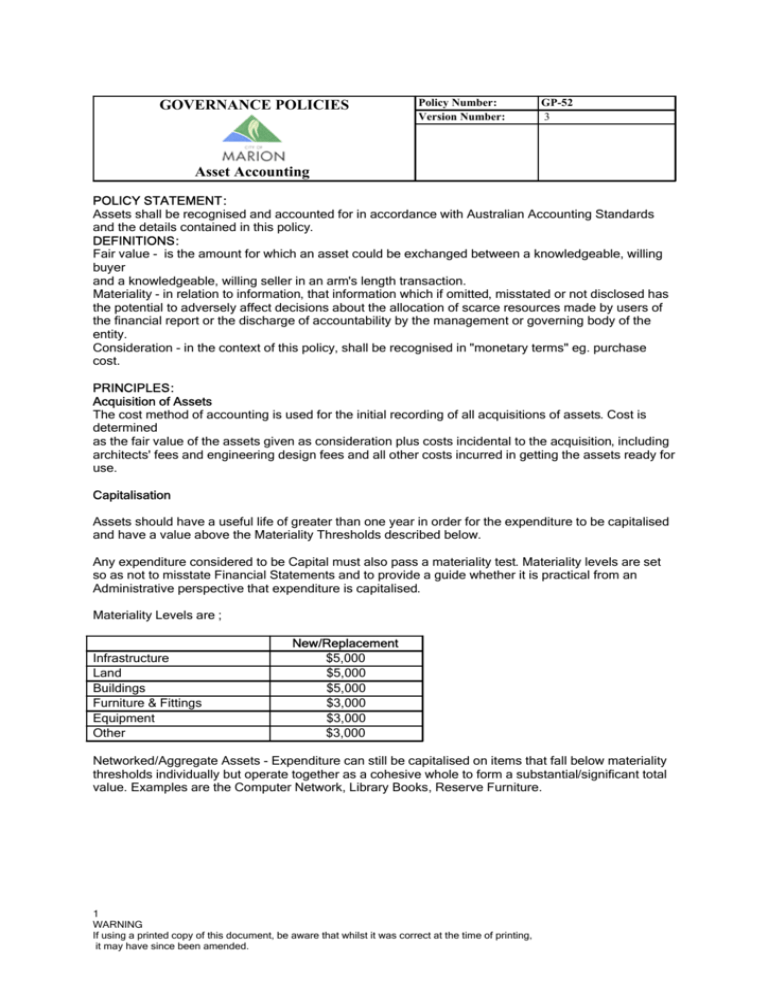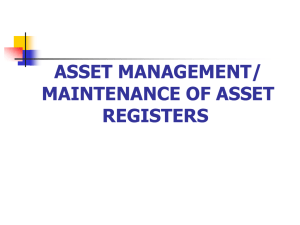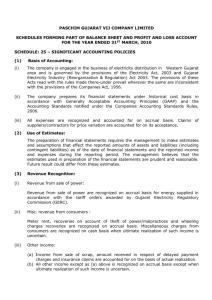Asset Accounting
advertisement

GOVERNANCE POLICIES Policy Number: Version Number: GP-52 3 Asset Accounting POLICY STATEMENT: Assets shall be recognised and accounted for in accordance with Australian Accounting Standards and the details contained in this policy. DEFINITIONS: Fair value - is the amount for which an asset could be exchanged between a knowledgeable, willing buyer and a knowledgeable, willing seller in an arm's length transaction. Materiality - in relation to information, that information which if omitted, misstated or not disclosed has the potential to adversely affect decisions about the allocation of scarce resources made by users of the financial report or the discharge of accountability by the management or governing body of the entity. Consideration - in the context of this policy, shall be recognised in "monetary terms" eg. purchase cost. PRINCIPLES: Acquisition of Assets The cost method of accounting is used for the initial recording of all acquisitions of assets. Cost is determined as the fair value of the assets given as consideration plus costs incidental to the acquisition, including architects' fees and engineering design fees and all other costs incurred in getting the assets ready for use. Capitalisation Assets should have a useful life of greater than one year in order for the expenditure to be capitalised and have a value above the Materiality Thresholds described below. Any expenditure considered to be Capital must also pass a materiality test. Materiality levels are set so as not to misstate Financial Statements and to provide a guide whether it is practical from an Administrative perspective that expenditure is capitalised. Materiality Levels are ; Infrastructure Land Buildings Furniture & Fittings Equipment Other New/Replacement $5,000 $5,000 $5,000 $3,000 $3,000 $3,000 Networked/Aggregate Assets - Expenditure can still be capitalised on items that fall below materiality thresholds individually but operate together as a cohesive whole to form a substantial/significant total value. Examples are the Computer Network, Library Books, Reserve Furniture. 1 WARNING If using a printed copy of this document, be aware that whilst it was correct at the time of printing, it may have since been amended. Maintenance or Capital Expenditure Maintenance Expenditure on a non-current asset that does not meet capitalisation criteria is considered maintenance expenditure and must be expensed as incurred. In general, maintenance expenditure will allow the asset to realise its expected service levels and estimated life. Capital Capital expenditure can relate to new or existing assets. Capital expenditure shall be recognised (taken into consideration materiality levels) where: z Expenditure results in an effective increase in future economic benefits z Expenditure results in an increase in the quality of services provided by the asset beyond that previously determined; or z Expenditure results in an effective extension to the asset’s useful life. Asset Stocktake A stocktake of current Inventory items will be conducted at least annually. Revaluations of Non -current Assets Infrastructure Assets and Library Stock are revalued annually. Land, Buildings and Other Assets are revalued with sufficient regularity to ensure the carrying amount does not differ materially from the fair value that would otherwise be determined at the reporting date. Plant, Equipment, Furniture and Fittings are recognised at cost less accumulated depreciation and any accumulated impairment and are not subject to revaluation. Non-monetary assets received without charge are recognised as assets and revenues at their fair value at the date of receipt, except for land under roads. Land under roads and trees are not recognised because there is currently no reliable method of valuation. Depreciation of Non -current Assets All non-current assets having a limited useful life are systematically depreciated over their useful lives in a manner which reflects the consumption of the economic benefits provided by those assets. Land is not a depreciable asset. The Depreciation method applied shall be the straight-line basis. Depreciation rates shall be reviewed each year. Current Depreciation Useful Lives: Plant and Equipment Buildings Office Furniture and Fittings Other Assets Library Stock Band Instruments Stone Lantern Monuments Civic Art Structures Infrastructure Assets Road Base Road Seal Kerb Footpath Other Road Structures Drainage Bridges 3-15 years 10-60 year 15 years 4 – 7 years 25 years 100 years 100 years 80 years 26 years 80 years 15 – 50 years 10 – 50 years 40 – 100 years 80 years Impairment 2 WARNING If using a printed copy of this document, be aware that whilst it was correct at the time of printing, it may have since been amended. Assets that have an indefinite useful life are not subject to depreciation and are reviewed annually for impairment. Assets that are subject to depreciation are reviewed for impairment whenever events or changes in circumstances indicate that the carrying amount may not be recoverable. Non-current Assets Constructed by the Council The cost of non-current assets constructed by the Council includes the cost of all materials used in construction, direct labour on the project and plant operating costs. Direct labour costs include an overhead component to cover leave, training and other employment costs. Land Held for Resale Land held for development and/or resale is valued at the lower of cost and net realisable value. Cost includes: z the cost of acquisition, development and interest incurred on financing of that land during its development. z interest and other holding charges incurred after development is complete are recognised immediately as expenses. z land held for development as community facilities is valued at the lower of cost and net realisable value. Cost includes the cost of acquisition and development. REFERENCES: Corporate Plan: Recognised for its Excellence in Governance. EG1-Apply the principles of business excellence to achieve best practice in governance. Procedure References : Other Related References : Australian Accounting Standards, Local Government Accounting Regulations Previous Versions : N/A 3 WARNING If using a printed copy of this document, be aware that whilst it was correct at the time of printing, it may have since been amended.







